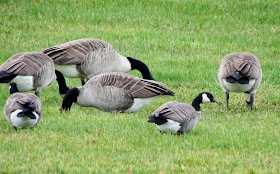You might have noticed it is cold. But that doesn't mean the fun has to stop, it only changes. Let's focus on some of the special happenings going on in Ohio in the fall, and yes, winter.
%2BWhoo's%2Bgot%2Bme.JPG) |
| Oh, this looks interesting! Bob Scott Placier gently handles a Saw-whet Owl. |
Saw-whet Owls invade parts of the United States in the fall. Leaving the forests of Canada, many cross Lake Erie to take up winter residence in Ohio, Pennsylvania and beyond. Researchers are just getting a good understanding of the habits of these nocturnal creatures. The group at Project OwlNet are the the primary movers and shakers of the studies.
In Ohio, we have Tom Bartlett banding these secretive owls on Kelleys Island. My good friend, Bob Scott Placier recently did a night time banding at Lowe-Volk Park in nearby Crawford County. He was able to band one of the elusive birds that evening, but in general, the numbers are down this year.
 |
| Cackling Geese, now coming to a inland lake near you! Note the stubby bill which is most diagnostic. |
 |
| Two Cackling Geese in the forground were about 65% smaller than the geese with which they were asscociating |
These Mallard-size geese are real stand-outs in a crowd. I spent a good bit of time studying the birds, and got some video as well. I will try to post that later.
The whole science of splitting out Crackling Geese has been called "hopelessly muddled" by several of America's best birders. So I will not attempt to explain them other than, when you see one- you will know it!
 |
| SNOW BUNTINGS! |
And with snow comes: Snow Buntings! Keep your eyes pealed while driving back country roads for these farm-field wonders from the north. Every day we are getting reports of more winter birds arriving!
 |
| Snowy Owl |
 |
| Short-eared Owls are winter fare. |
- This weekend, the Ohio Natural Areas and Preserves Association will be birding at La Due Resivoir and I hope to see you there on Saturday Nov. 22, Please go to their website for details.
- The ONAPA birding is from 10:00-2:00 and following at 3:00 pm is Greater Cleveland Audubon's program and refreshments at nearby Novak Education Center, 382 Townline Road in Aurora, Ohio (3-5pm). The speaker will be someone you might know, a Weedpicker. I will be talking about Birding by Habitat, and Habitats for Birds.












